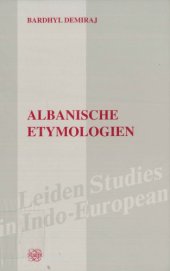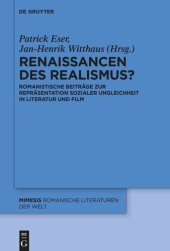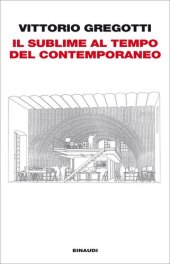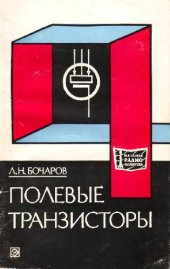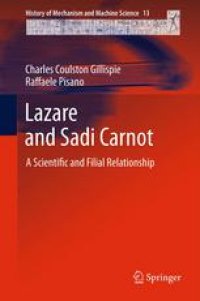
Ebook: Lazare and Sadi Carnot: A Scientific and Filial Relationship
- Genre: History // Memoirs; Biographies
- Series: History of Mechanism and Machine Science 13
- Year: 2013
- Publisher: Springer Netherlands
- Language: English
- pdf
Lazare Carnot was the unique example in the history of science of someone who inadvertently owed the scientific recognition he eventually achieved to earlier political prominence. He and his son Sadi produced work that derived from their training as engineering and went largely unnoticed by physicists for a generation or more, even though their respective work introduced concepts that proved fundamental when taken up later by other hands. There was, moreover, a filial as well as substantive relation between the work of father and son. Sadi applied to the functioning of heat engines the analysis that his father had developed in his study of the operation of ordinary machines. Specifically, Sadi's idea of a reversible process originated in the use his father made of geometric motions in the analysis of machines in general.
This unique book shows how the two Carnots influenced each other in their work in the fields of mechanics and thermodynamics, and how future generations of scientists have further benefited from their work.
Lazare Carnot was the unique example in the history of science of someone who inadvertently owed the scientific recognition he eventually achieved to earlier political prominence. He and his son Sadi produced work that derived from their training as engineering and went largely unnoticed by physicists for a generation or more, even though their respective work introduced concepts that proved fundamental when taken up later by other hands. There was, moreover, a filial as well as substantive relation between the work of father and son. Sadi applied to the functioning of heat engines the analysis that his father had developed in his study of the operation of ordinary machines. Specifically, Sadi's idea of a reversible process originated in the use his father made of geometric motions in the analysis of machines in general.
This unique book shows how the two Carnots influenced each other in their work in the fields of mechanics and thermodynamics, and how future generations of scientists have further benefited from their work.
Content:
Front Matter....Pages i-xvi
Biographical Sketch of Lazare Carnot....Pages 1-13
The Science of Machines....Pages 15-45
The Development of Carnot’s Mechanics....Pages 47-86
The Carnot Approach and the Mechanics of Work and Power, 1803–1829....Pages 87-105
An Engineering Justification of Algebra and the Calculus....Pages 107-131
History and Historiography of Sadi Carnot’s Thermodynamics....Pages 133-189
On Principles in Sadi Carnot’s Thermodynamics....Pages 191-225
What Are the Scientific Roots of Sadi Carnot’s Cycle?....Pages 227-256
A Historical Epistemology of Thermodynamics. The Mathematics in Sadi Carnot’s Theory....Pages 257-291
Studies and Heritage of R?flexions sur la puissance motrice du feu ....Pages 293-335
Final Remarks on the Scientific Relationship Between P?re et Fils ....Pages 337-411
Back Matter....Pages 413-490
Lazare Carnot was the unique example in the history of science of someone who inadvertently owed the scientific recognition he eventually achieved to earlier political prominence. He and his son Sadi produced work that derived from their training as engineering and went largely unnoticed by physicists for a generation or more, even though their respective work introduced concepts that proved fundamental when taken up later by other hands. There was, moreover, a filial as well as substantive relation between the work of father and son. Sadi applied to the functioning of heat engines the analysis that his father had developed in his study of the operation of ordinary machines. Specifically, Sadi's idea of a reversible process originated in the use his father made of geometric motions in the analysis of machines in general.
This unique book shows how the two Carnots influenced each other in their work in the fields of mechanics and thermodynamics, and how future generations of scientists have further benefited from their work.
Content:
Front Matter....Pages i-xvi
Biographical Sketch of Lazare Carnot....Pages 1-13
The Science of Machines....Pages 15-45
The Development of Carnot’s Mechanics....Pages 47-86
The Carnot Approach and the Mechanics of Work and Power, 1803–1829....Pages 87-105
An Engineering Justification of Algebra and the Calculus....Pages 107-131
History and Historiography of Sadi Carnot’s Thermodynamics....Pages 133-189
On Principles in Sadi Carnot’s Thermodynamics....Pages 191-225
What Are the Scientific Roots of Sadi Carnot’s Cycle?....Pages 227-256
A Historical Epistemology of Thermodynamics. The Mathematics in Sadi Carnot’s Theory....Pages 257-291
Studies and Heritage of R?flexions sur la puissance motrice du feu ....Pages 293-335
Final Remarks on the Scientific Relationship Between P?re et Fils ....Pages 337-411
Back Matter....Pages 413-490
....

